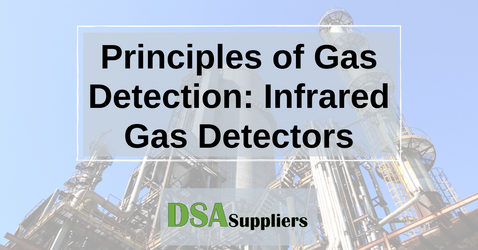Principles of Gas Detection: Infrared Gas Detectors
Posted by Claire Allcock on 9th Apr 2020
Infrared absorption has been used as an analytical tool for many years and continues to be a valued method for gas detection. Learn the differences in infrared gas detectors, and how they can be used to protect your environment.
Since the 1980s, electronic and optical advances have made it possible to design smaller, lower power equipment for industrial gas detection products. They work on the principle that gas concentration is based on the absorption of IR radiation at certain wavelengths, as the radiation passes through a volume of the gas.
There are two main types of IR detectors; the point detector and the open path detector.
Point Infrared Detectors
Point IR detectors are commonly used to monitor concentrations of hydrocarbon gases in the atmosphere, which can ignite and cause an explosion if the concentration exceeds the Lower Explosive Level (LEL) of the gas.
For point detectors, the absorption path length is fixed and is usually a few inches in front of the sensor. Therefore, if there are multiple sites for potential gas leakage, you will need multiple point sensors.
To determine a concentration of the target gas, the concentration of gas is measured by the infrared absorption of an optical beam known as the active beam. A second beam is used as a reference, which follows the same path but contains IR radiation at a wavelength not absorbed by the gas. This second beam acts as a failsafe for the detector.
The beams are pulsed alternately and are received by the detector after being guided on their optical path. All components are housed in an explosion-proof enclosure, with infrared-transparent optical windows.
Open Path Infrared Detectors
Similarly to point detectors, open path IR detectors work on the same principle of an active and reference beam. The difference with open path detectors is that their gas sampling path can be as long as 130 metres, enabling them to cover large open areas or monitor environments where gases can be dispersed by wind or natural diffusion.
Because of the larger sampling distances, open path detectors cannot pinpoint the location of a gas leak; instead, the leak can be anywhere on the sampling path. Because of this, concentration output is usually expressed in ppm.metres or LEL.metres since only the product of the average gas concentration and gas cloud length can be calculated.
Open path systems have an advantage over point systems in that they can monitor several potential leak sites (if they are in a line, such as a row of valves or pumps). They are also useful for monitoring the perimeter for leaks and a mirror can be used to direct the path around a corner to the receiver.
Advantages of IR Detectors
The major advantages of IR detectors apply to both point and open path systems.
- Immune to contamination and poisoning.
- IR detectors tend to outlast catalytic sensors.
- Require less calibration.
- Able to operate in varying levels of oxygen concentration.
- Able to operate in the continuous presence of a target gas.
- Can perform more reliably in varying flow conditions.
- Even when flooded with gas, IR detectors will continue to show high readings and the sensor will not be damaged.
- Able to detect gases at levels above 100 % LEL.
Disadvantages of IR Detectors
Similarly to all gas detectors, IR detectors are not the ideal solution for every situation.
- Require a higher initial investment, as IR detectors tend to be more expensive.
- Spare parts tend to be more expensive.
- Gases that do not absorb IR energy (such as hydrogen) are not detectable.
- High humidity, dusty and/or corrosive field environments can increase IR detector maintenance costs.
- Temperature range for detector use is limited.
- May not perform as well in environments where multiple gases are present.
Infrared gas detectors are a great solution for many workplaces that require hydrocarbon gas monitoring. If you want to learn more or discuss your individual requirements, get in touch with us at DSA Suppliers.

